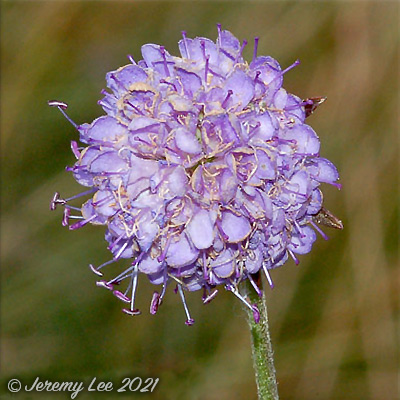
 |
|
Scientific Classifications explained » Amphibians » Ants » Aphids » Bees » Beetles » Birds » Bugs » Butterflies » Caterpillars » Damselflies » Dragonflies » Earwigs » Flies » Frog/Leafhoppers » Fungi » Galls » Grasshoppers » Harvestmen » Hoverflies » Lacewings » Ladybirds » Leaf Mines » Lichens » Mammals » Millipedes » Mosses » Moths » Sawflies » Slugs » Snails » Spiders » Trees & Shrubs » Wasps » Wild Flowers » Woodlice » Postboxes |
UK Nature > Wild Flowers > Blue & Purple Wild Flowers > Succisa pratensis

Scientific Name: Succisa pratensis Common Name: Devil's-bit Scabious Succisa pratensis, more commonly known as Devil's-bit Scabious, is so named because its roots end abruptly as though bitten off by the devil. It has a distinctive violet-blue, ‘pincushion’ flower-head backed by green bracts. The leaves of the basal rosette are elliptical, dark green and often blotched with purple whilst the few on the stem are narrower and occasionally toothed. Flowers appear from June to October. Devil's-bit scabious is a slow growing, native perennial of damp to reasonably free-draining soils with a preference for those that are neutral to mildly acidic. It exploits areas where more dominant species are held in check through grazing pressure or low fertility and is found in a range of habitats including hay meadows, damp pasture, woodland rides, heaths and mires. It provides nectar for hoverflies, bees and butterflies, and is the larval food plant of the rare marsh fritillary. |
|

https://www.uknature.co.uk is a website dedicated to showing the immense diversity of UK nature and wildlife. Our vast range of habitats, from lowland arable to snow covered mountains, from storm-ravaged coastlines to peaceful inland freshwater lakes and rivers, from dry, sandy heaths to deciduous and coniferous forests, all these habitats contribute to the abundance of UK nature. We have wild birds in huge numbers either residing or visiting our shores (597 recorded species as at July 2013) and we must also not forget the humble back garden with its grass lawns, flower beds filled with nectar rich flowers, shrubs and trees, all designed to attract huge numbers of insects such as bees, moths, butterflies and hoverflies; and finally the small ponds which provide safe havens for frogs, toads, newts and even slow worms and grass snakes. www.uknature.co.uk is the showcase for my personal passion, photographing uknature in all its glory. I sincerely hope you all enjoy the fruits of my labours. This site and all images contained therein is © Jeremy Lee 2004 - 2025. All Rights Reserved. Site design by Jeremy Lee. Site development & IT Support by Stuart Lee. |